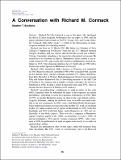Files in this item
A conversation with Richard M. Cormack
Item metadata
| dc.contributor.author | Buckland, Stephen Terrence | |
| dc.date.accessioned | 2016-05-25T15:30:05Z | |
| dc.date.available | 2016-05-25T15:30:05Z | |
| dc.date.issued | 2016-05 | |
| dc.identifier | 241366204 | |
| dc.identifier | 1e77f699-8b4a-411c-8385-92fd6b2c7279 | |
| dc.identifier | 84971578875 | |
| dc.identifier | 000376516700002 | |
| dc.identifier.citation | Buckland , S T 2016 , ' A conversation with Richard M. Cormack ' , Statistical Science , vol. 31 , no. 2 , pp. 142-150 . https://doi.org/10.1214/15-STS543 | en |
| dc.identifier.issn | 0883-4237 | |
| dc.identifier.other | ORCID: /0000-0002-9939-709X/work/73701037 | |
| dc.identifier.uri | https://hdl.handle.net/10023/8869 | |
| dc.description.abstract | Richard Melville Cormack is one of the giants who developed the theory of mark-recapture. Referring to his key paper in 1964, and the papers published back-to-back in 1965 by George Jolly and George Seber, the `Cormack-Jolly-Seber model' is central to the development of mark-recapture methods for estimating survival. Richard was born on 12 March 1935. His father was Principal of Stow College of Engineering in Glasgow. From the age of 7, Richard attended Glasgow Academy, and later entered directly into the second year at Kings College, Cambridge, intending at the time to be a theoretical astronomer. He secured first class honours in Special Mathematics from London as an external student in 1954, and second class honours in Mathematics from Cambridge in 1955. After changing direction, he left Cambridge in 1956 with a Distinction in the Diploma in Mathematical Statistics. Richard's PhD, undertaken while a lecturer at Aberdeen, was completed in 1961. Richard's period at Aberdeen (1956-66) coincided with a golden era for statistics there, and his colleagues included D.J. Finney, Bill Brass, Peter Fisk, David M.G. Wishart, Michael Sampford, Robert Curnow, George Jolly and Andrew Rutherford (the last four being members of the ARC Unit of Statistics). In common with a number of these colleagues, he moved to Edinburgh in 1966, holding a Senior Lectureship there until 1972, when he became the first Professor of Statistics at St Andrews. Richard's groundbreaking contributions to mark-recapture in the early 1960s continued when he addressed the issue of heterogeneity in capture probabilities, publishing a test for heterogeneity in Biometrics in 1966. Then in 1972, in another Biometrics paper, he showed the logic behind capture-recapture estimates, making the methods more accessible and understandable to the user community. In 1981, jointly with Philip North, Richard published important insights into mark-recovery models. His work on log-linear models for mark-recapture led to papers in Biometrika in 1984 (with Ron Sandland) and 1991 (with Peter Jupp), and in Biometrics in 1989, and additionally, to four book chapters. There was also a sequence of Biometrics capture-recapture papers in the 1990s: on modelling covariates (1990), on interval estimation (1992) and on variance estimation (1993). After retirement in 1994, his publications in mark-recapture were mostly as co-author in epidemiology studies. Richard also published on other diverse topics, often with scientists from other disciplines. His 1971 review of classification, read to the Research Committee of RSS and later appearing in JRSS A, is a classic, and while his 1988 exposition on statistical challenges in the environmental sciences (also in JRSS A) has had substantially less impact, it too showed his characteristic incisiveness. His contributions to a wide range of committees, working groups, visiting groups and scientific organisations (including council member for NERC and the Freshwater Biological Association) were substantial. He was elected a member of the ISI in 1962 and a Fellow of the Royal Society of Edinburgh in 1974. He held various offices within the Biometric Society, as Secretary of the British Region 1970-77, Regional President 1990-92 and President of the International Society 1980-81. He served on the Council and various committees of the Royal Statistical Society. Richard married Edith Whittaker on 1st September 1960, at King's College Chapel, Aberdeen. Edith is a plant ecologist, and a past chairperson of the Fife and Kinross Branch of the Scottish Wildlife Trust and of the Friends of St Andrews Botanic Garden: she was also a founding member of the Garden's Education Trust. Their son Andrew is a European Chartered Engineer working for the JANET network, while their daughter Anne is a Marketing Manager. Photography has been a passion of Richard's for many decades. He was lecturer and judge for 40 years for the Scottish Photographic Federation, and was placed on their roll of honour. He has held exhibitions in Dundee (Land of the Berbers), St Andrews (Growth and Form) and Aberdeen (Walking in the North), and has given many talks. Richard firmly established the University of St Andrews as a centre for statistical ecology, a strength that continues today. | |
| dc.format.extent | 201099 | |
| dc.language.iso | eng | |
| dc.relation.ispartof | Statistical Science | en |
| dc.subject | GE Environmental Sciences | en |
| dc.subject | QA Mathematics | en |
| dc.subject | T-NDAS | en |
| dc.subject.lcc | GE | en |
| dc.subject.lcc | QA | en |
| dc.title | A conversation with Richard M. Cormack | en |
| dc.type | Journal article | en |
| dc.contributor.institution | University of St Andrews. School of Mathematics and Statistics | en |
| dc.contributor.institution | University of St Andrews. Marine Alliance for Science & Technology Scotland | en |
| dc.contributor.institution | University of St Andrews. Scottish Oceans Institute | en |
| dc.contributor.institution | University of St Andrews. St Andrews Sustainability Institute | en |
| dc.contributor.institution | University of St Andrews. Centre for Research into Ecological & Environmental Modelling | en |
| dc.identifier.doi | 10.1214/15-STS543 | |
| dc.description.status | Peer reviewed | en |
This item appears in the following Collection(s)
Items in the St Andrews Research Repository are protected by copyright, with all rights reserved, unless otherwise indicated.

